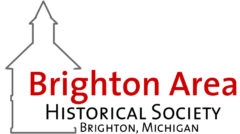The history of St. Pauls Episcopal Church dates from the 1830s when the Rev. Wm. A. Clark, D.D., rector of All Saints Church of New York City journeyed to the West and visited this part of the territory of Michigan. Being pleased with the area, he took up land in Brighton Township and moved his family here in 1837. He immediately began holding church services, the first one in his orchard; the first regular Protestant religious services held in this area.
In what is now the City of Brighton, he set aside land to be used as a burying ground, one acre of which was reserved as the site for a church. Dr. Clark died in September, 1841, at 55, and with his wife, Jacintha, is buried in the village cemetery. William A. Clark, Jr., a son, granted with a warranty deed the burying ground to a group of prominent citizens to become the village cemetery. In March 1880, this son and his wife deeded the acre reserved for a church to the Church association of Michigan for one cent and other good and valuable considerations.
Nearly forty years after the death of Dr. Clark, Brighton Episcopalians began a church building. The will of Chloe Clark, a daughter, directed her lands be sold and the proceeds to bused in the construction of a Protestant Episcopal Church in Brighton; to be a memorial to her father and sister Mary. Mrs. George English, formerly Sophia Fonda of Fonda Lake was a major supporter of this effort. She obtained $1,000 from friends in New York, a communion service, an organ, a bible and alter hanging which had been used in Trinity Church, New York City. At her request, the church as called St. Pauls. Her sister gave the altar cross and the flower vases. The original altar was a specific memorial to Chloe and Mary Clark. The fine rose window was given by Bishop Harris.
Patterned after a little chapel in England, the building was erected by a local contractor, James Collett. The cornerstone was laid in May 1880, by Bishop Harris in the presence of Rev. Rufus W. Clark. A son of Dr. Clark. Consecration was by Bishop Harris in August, 1881.
This church has been through many troubled periods, having been closed for a ten year period in the 1930s. During those years church records were stored in the home of Dr. F. M. Blatchford. When that home was completely destroyed by fire, records from 1886 to 1932 were lost. However, the church does have the names of 20 vicars and Rectors who served following the Rev. Wm. A. Clark.
Located by the Brighton Mill Pond, this active congregation continues in its efforts to glorify God by serving all sorts and conditions of men.
